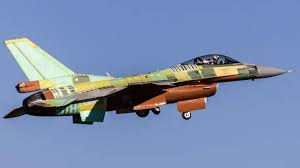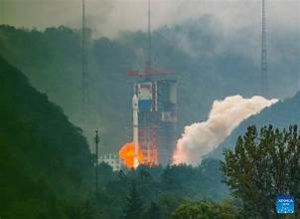Bulgarian F-16 Block 70 soars in historic first flight triumph

Sofia: On a crisp late spring afternoon at Graf Ignatievo Air Base in central Bulgaria, a sleek F-16 Block 70 fighter jet roared into the skies for its inaugural flight on Bulgarian soil, a significant step in the nation’s military modernization.
The flight, conducted on May 28, 2025, marked the completion of the aircraft’s technical acceptance and the start of its flight evaluation phase, as confirmed by Bulgaria’s Ministry of Defense. This event signals not only the arrival of a cutting-edge multirole fighter but also Bulgaria’s commitment to aligning its air force with NATO standards, replacing its aging fleet of Soviet-era MiG-29s.
For the United States, which has supported Bulgaria’s acquisition through a $1.3 billion contract with Lockheed Martin, the flight underscores the enduring partnership between the two nations and the global reach of the F-16 program. As Bulgaria integrates this advanced platform, the event raises questions about the challenges of adopting high-tech military systems in a rapidly evolving defense landscape.
The F-16 Block 70, the most advanced iteration of Lockheed Martin’s iconic Fighting Falcon, touched down at Graf Ignatievo on April 2, 2025, after a transatlantic ferry flight from the company’s production facility in Greenville, South Carolina.
The aircraft, a two-seater combat training variant bearing tail number 301, was formally welcomed during a ceremony attended by Bulgarian Prime Minister Rossen Zhelyazkov, Defense Minister Atanas Zapryanov, and U.S. representatives. The jet is the first of 16 ordered by Bulgaria in two batches, with eight expected by the end of 2025 and another eight by 2027, according to Lockheed Martin.
The acquisition, valued at $1.3 billion for the initial batch, is part of Bulgaria’s long-standing effort to modernize its air force, a process delayed by financial constraints and the COVID-19 pandemic, which pushed back the original 2023 delivery schedule.
The significance of this first flight extends beyond a single aircraft taking to the skies. It represents a pivotal moment for Bulgaria, a NATO member since 2004, as it transitions from reliance on Soviet-designed aircraft to a platform that enhances interoperability with allied forces.
The F-16 Block 70 is engineered for seamless integration with NATO’s air defense networks, enabling Bulgaria to contribute to collective security missions such as air policing over the Black Sea region. The aircraft’s advanced systems, including its radar and weaponry, position it as a versatile tool for both air-to-air combat and precision strikes against ground targets, capabilities that are critical in today’s complex security environment.
The F-16 Block 70 is a technological leap forward from its predecessors, designed to meet the demands of modern warfare while maintaining the affordability and reliability that have made the F-16 a mainstay for 29 air forces worldwide.
At its core is the Northrop Grumman APG-83 Scalable Agile Beam Radar [SABR], an Active Electronically Scanned Array [AESA] system that provides superior target detection and tracking over long ranges.
Unlike mechanically scanned radars found in older F-16 variants like the Block 50/52, the APG-83 uses electronic beam steering to monitor multiple targets simultaneously, offering enhanced resistance to electronic jamming.
This radar enables the aircraft to engage threats in cluttered environments, a critical feature for operations in contested airspace. The jet’s avionics suite includes a modernized cockpit with high-resolution displays, an upgraded mission computer, and the Link 16 data-sharing system, which allows real-time coordination with NATO assets. These systems ensure that pilots can process vast amounts of data quickly, making the F-16 Block 70 a force multiplier in joint operations.
Powering the aircraft is the General Electric F110-GE-129 engine, delivering 29,000 pounds of thrust, which propels the jet to a maximum speed of Mach 2 and a service ceiling of 50,000 feet. The engine’s reliability and performance enable the F-16 to undertake a wide range of missions, from high-speed intercepts to sustained low-altitude operations.
The airframe itself has been enhanced for durability, boasting a structural service life of 12,000 flight hours, 4,000 more than earlier models, according to Lockheed Martin. This extended lifespan ensures that Bulgaria’s investment will remain viable for decades, a crucial consideration for a nation balancing modernization with budget constraints.
Compared to platforms like the Russian Su-35, which offers greater thrust and maneuverability, the F-16 Block 70 prioritizes versatility and integration, trading some raw performance for advanced electronics and NATO compatibility. Against China’s J-20, a fifth-generation stealth fighter, the F-16 lacks stealth capabilities but compensates with proven reliability and a lower operational cost.
The aircraft’s weaponry further enhances its multirole capabilities. It can carry an array of munitions, including the AIM-120C-7/8 Advanced Medium-Range Air-to-Air Missile [AMRAAM], which provides beyond-visual-range engagement, and the AIM-9X Sidewinder for close-in dogfights.
For ground attacks, the F-16 Block 70 is equipped to deploy precision-guided munitions like the GBU-39/B Small Diameter Bomb, which offers pinpoint accuracy with reduced collateral damage. These weapons allow the jet to perform air superiority missions, intercept hostile aircraft, and support ground forces with surgical strikes.
In contrast to Bulgaria’s MiG-29s, which rely on outdated radar and less precise munitions, the F-16’s arsenal provides a significant upgrade, aligning with NATO’s emphasis on precision and interoperability. However, the absence of stealth features limits its survivability against advanced air defense systems, a gap that platforms like the F-35 address but at a much higher cost.
The path to this first flight was not without hurdles. Upon arrival in April, the aircraft experienced a system deviation detected during initial testing, grounding it until repairs were completed. Major General Nikolay Rusev, Commander of the Bulgarian Air Force, described the issue as a routine hardware malfunction identified by the American pilot during delivery, emphasizing that it did not indicate a defective aircraft.
The necessary spare part, not included in the initial delivery package to reduce costs, was supplied by Lockheed Martin, allowing the jet to proceed to technical acceptance. This incident sparked controversy in Sofia, with some lawmakers alleging sabotage and calling for a parliamentary investigation, though no evidence of foul play has emerged.
Defense Minister Zapryanov clarified that the fault was addressed under Lockheed Martin’s oversight, and the aircraft was cleared for flight testing, as reported by Euractiv. The episode highlights the complexities of integrating advanced technology, particularly for a nation transitioning from Soviet-era equipment to Western systems.
The flight on May 28 was a critical step in the aircraft’s acceptance process, which consists of two phases: technical and flight evaluations. Technical acceptance involved rigorous checks of the jet’s systems, from avionics to hydraulics, to ensure compliance with operational standards.
The flight evaluation, now underway, tests the aircraft’s performance in real-world conditions, including maneuverability, sensor functionality, and systems integration. According to the Bulgarian Ministry of Defense, two flights with Bulgarian pilots are required to complete this phase, ensuring that local crews are familiar with the jet’s capabilities.
The successful completion of the first flight, conducted at 4:57 p.m. local time, was met with enthusiasm, with social media posts from aviation enthusiasts like @gpaviophoto celebrating the milestone and wishing for “safe and trouble-free flights.” The event was also noted by regional outlets, with posts on X describing it as a proud moment for Bulgaria’s air force.
Integrating the F-16 into Bulgaria’s air force presents significant logistical and technical challenges. Graf Ignatievo, the country’s only active combat air base, requires upgrades to accommodate the new jets, including modern maintenance facilities and a flight simulator, the construction of which has faced delays.
Training pilots and ground crews is another hurdle, as transitioning from the MiG-29 to the F-16 demands specialized skills. Bulgarian pilots have been training in the United States, but building a self-sufficient training program in Bulgaria will take time.
The $1.3 billion contract with Lockheed Martin includes support for training and logistics, but the absence of a comprehensive spare parts package, as noted by General Rusev, underscores the trade-offs made to manage costs.
These challenges are not unique to Bulgaria; other NATO nations, such as Romania and Slovakia, have faced similar obstacles when adopting Western aircraft, highlighting the steep learning curve of transitioning to advanced platforms.
The F-16 Block 70’s arrival aligns with broader trends in NATO’s eastern flank, where countries are modernizing their air forces to counter regional threats. Poland, for instance, has invested in F-35 stealth fighters, while Romania operates older F-16s acquired from Portugal.
Bulgaria’s adoption of Block 70 positions it as a key player in regional air defense, particularly in the Black Sea region, where NATO conducts regular air policing missions. The jet’s interoperability, facilitated by systems like Link 16, allows it to share data with allied aircraft and ground stations, enhancing coordinated responses to potential threats.
Compared to Russia’s Su-35, which boasts superior maneuverability but lacks NATO integration, the F-16 offers a balanced solution for Bulgaria’s needs. However, the jet’s reliance on conventional radar and lack of stealth features raise questions about its long-term effectiveness against emerging threats, such as advanced surface-to-air missiles.
Historically, Bulgaria’s air force has relied on Soviet-era equipment, with its fleet of 12 MiG-29s serving as the backbone of its air defense for decades. The MiG-29, while agile, suffers from outdated avionics and limited compatibility with NATO systems, making joint operations challenging.
Efforts to replace these jets began in the early 2000s, but financial constraints and political debates delayed progress. The 2019 contract with Lockheed Martin marked a turning point, signaling Bulgaria’s shift toward Western technology.
The F-16’s operational history, with over 3,100 aircraft in service globally, provides a proven track record, from combat operations in Iraq and Afghanistan to air policing in Europe. Its versatility has made it a cornerstone of NATO air forces, and Bulgaria’s acquisition strengthens the alliance’s collective defense posture.
The global F-16 program continues to evolve, with Lockheed Martin managing a backlog of 114 Block 70/72 jets at its Greenville facility, 26 of which have been delivered to international partners, including Taiwan and Slovakia.
The aircraft’s enduring appeal lies in its balance of cost, capability, and adaptability, making it a practical choice for nations like Bulgaria that cannot afford fifth-generation fighters like the F-35. Yet, the F-16’s limitations, particularly its lack of stealth, highlight the trade-offs inherent in modernizing on a budget.
As Bulgaria builds its F-16 squadron, it must address gaps in infrastructure, training, and logistics to maximize the platform’s potential. The successful first flight is a promising start, but sustained investment will be critical to ensuring operational readiness.
The F-16 Block 70’s maiden flight in Bulgaria is more than a ceremonial milestone; it is a testament to the nation’s determination to strengthen its air defenses and deepen its integration with NATO.
The aircraft’s advanced systems, from its AESA radar to its precision weaponry, offer a significant upgrade over Bulgaria’s aging MiG-29s, enabling the country to play a more active role in regional security. Yet, the challenges of integration, from technical glitches to infrastructure delays, underscore the complexities of adopting a high-tech platform.
As Bulgaria moves toward operational deployment, the focus will shift to sustaining this capability over the long term, a task that will test the nation’s resources and resolve.
Will Bulgaria leverage the F-16’s potential to become a stronger NATO partner, or will logistical and financial hurdles limit its impact? The answer lies in the years ahead, as the country navigates the demands of modern air warfare.





